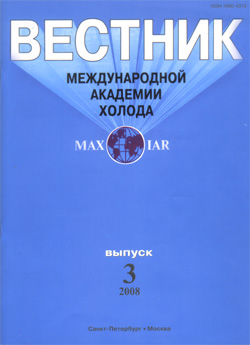
Calculation of local heat transfer at refrigerant boiling in confined space

Annotation
The main models of pool boiling are presented: the one for energetics by G. Kruzhilin and the one for refrigeration engineering by G. Danilova. General equations of heat transfer for forced motion of boiling liquid in confined space are presented: for calculating average heat transfer and for local heat exchange. Flow patterns of boiling liquids in confined space for various heat exchangers are demonstrated. Bubble boiling at the surface, convective component of forced motion, and convective evaporation are identified as the main components of heat exchange. Convective evaporation is the basis for heat transfer in annular flow which is the most characteristic for boiling in the channels of narrow flow area. Method by S. Kutateladze, associating the influence of bubble boiling with forced convection, and the Martinelli–Nelson model of separated flows, describing convective evaporation, are presented as the examples of evaluating the influence of various heat exchange mechanisms. Vapor voidage is identified as the main parameter influencing the character of heat exchange at convective evaporation. The most important methods of calculation based on the investigation of boiling in the tubes of more than 6 mm diameter have been analyzed. The comparison of experimental data on heat transfer at boiling in minichannel with the calculations using the popular models allowed identifying a certain peculiarity of heat-hydrodynamic processes in the channels of narrow flow area. When comparing the experimental results with the calculations according to the methods by Ogata, Sato, and Park methods only partial agreement between them is seen, which is probably due to the difference in heat transfer mechanisms in macro micro microchannels. A modification of the Shah model using true phase parameters allows 30-16% agreement between calculated and experimental data.
Keywords
Постоянный URL
Articles in current issue
- The 28th General annual meeting of the International Academy of Refrigeration
- The results of the activities of the IAR in 2019-2020 and objectives for 2021-2022 (Report of the IAR President at the 28th General Annual Meeting on April 20, 2021)
- Slides for the report
- Method for calculating latent heat thermal energy storage
- On evaporative cooling of compressor
- Methods for regulating the performance of screw compressors
- Selection of effective cargo containment systems (LNG) for self-propelled and tug and barge transport
- Improving performance characteristics of mobile low power heating blocks
- Influence of the immune modulator as a feed additive for bees on the honey quality and biosafety
- Microbiological aspects of biotechnology safety for the production of glazed chewing marmalade based on extracts from medicinal plant raw materials
- Nutritional value of buckwheat from the Altai territory of Russia
- Experimental modelling of soil thawing
- Calculation of local heat transfer at refrigerant boiling in confined space
- Method of engineering calculation of the fire resistance limit for load-bearing metal structures
- Ethane phase equilibrium line
- Scientific and Technical Conference with International Participation "Transformations of low-temperature power systems in the context of ecological globalism»
- Requirements for manuscripts in the Journal of IAR
